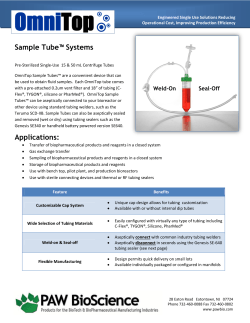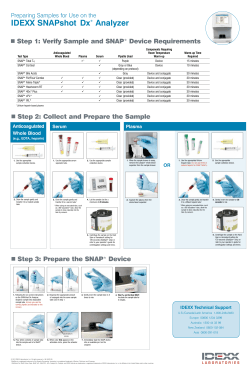
Blood Collection Tubes Order of Draw
Blood Collection Tubes Order of Draw Blood collection tubes must be filled in a specific sequence to minimize contamination of sterile specimens, avoid possible test result error caused by carryover of additives between tubes, and reduce the effect of microclot formation in tubes. When collecting blood samples, allow the tube to fill completely to ensure the blood/additive ratio necessary for accurate results. Gently invert each tube the required number of times immediately after collection to adequately mix the blood and additive. Never pour blood from one tube into another tube. See www.calgarylabservices.com/lab-services-guide/lab-tests/ for specific information for the collection and handling of each laboratory test. Order Color of Stopper Invert Additive Comments/Common Tests of Draw 1 Clear Not required No additive Tube used ONLY as a discard tube. 2 Blood Culture Bottle Invert gently to mix Bacterial growth medium and activated charcoal When a culture is ordered along with any other blood work, the Blood Cultures MUST be drawn first. 3 Yellow with clear label 8 to 10 times Sodium polyanethol sulfonate (SPS) Tube used for Mycobacteria (AFB) blood culture. 4 Royal Blue (with red band on label) Not required Glass tube with no additive Tube used for serum trace element tests. Available from CLS Referrals, the red band on label is applied by CLS Referrals before sending tubes to collection site. 5 Red GLASS Not required Glass tube with no additive 6 Light Blue 3 to 4 times 3.2% buffered Sodium citrate anticoagulant Tube used for serum tests, which CANNOT be collected in SST tubes. NOTE: red PLASTIC tubes are preferable for lab tests. Tube used mainly for PT (INR), PTT, and other coagulation studies. 3 to 4 times 3.2% Sodium citrate anticoagulant Tube used for ESR ONLY. 7 Black GLASS 8 Red 5 times Clot activator, and no anticoagulant Tube used for serum tests, which CANNOT be collected in SST tubes. 9 Gold 5 times Gel separator and clot activator Usually referred to as “SST” (serum separator tube). After centrifugation, the gel forms a barrier between the clot and the serum. 10 Dark Green 8 to 10 times Sodium heparin anticoagulant Tube used mainly for Amino Acids and Cytogenetics tests. 11 Light Green (mint) 8 to 10 times Lithium heparin anticoagulant and gel separator 12 Royal Blue (with blue band on label) 8 to 10 times K2EDTA anticoagulant Usually referred to as “PST” (plasma separator tube). After centrifugation, the gel forms a barrier between the blood cells and the plasma. Tube used mainly for Chemistry tests. Tube used for Trace Elements. 13 Royal Blue (with lavender band on label) 8 to 10 times Na2EDTA anticoagulant Tube used for whole blood trace element tests. Available from CLS Referrals, the lavender band on label is applied by CLS Referrals before sending tubes to collection site. 14 Lavender 8 to 10 times K2EDTA anticoagulant 15 Yellow with yellow banded white label 8 to 10 times Acid citrate dextrose solution ‘A’ (ACDA) Tube used mainly for CBC, pre-transfusion testing, Hemoglobin A1C, and anti-rejection drugs. Note: EDTA tubes specifically for Catecholamines also include Sodium metabisulfite. Tube used for Tissue Typing and some Flow Cytometry testing. 16 Grey 8 to 10 times Sodium fluoride and Potassium oxalate anticoagulant Visit www.Calgarylabservices.com for the most current version of this document SC100 Order of Draw Order of Transfer Attachment 1 Tube used for Lactate. 20140530
© Copyright 2025





















